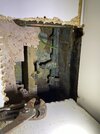- Joined
- 18 Jul 2023
- Messages
- 2
- Reaction score
- 0
- Country

Evening all.
After suspecting for years that our property never had an internal stopcock when we fitted the bathroom a couple years ago, I recently had the kitchen plinths out to investigate some rodent activity and set some traps and I ended up finding a lead pipe in the far corner which the kitchen fitter didn’t cut out when we had the kitchen done about 14 years ago.
Having managed to locate the incoming lead mains and find a stopcock in the far corner of the cupboards next to the cooker, it appears that the stop cock was seized up and there isn’t a great deal of access to get at it properly (I don’t want to rip anything out for the sake of this). After a bit of fiddling around I managed to free up the spindle and gave it all a clean down with a wire brush, but it appears that the round packing nut appears to be ceased onto the shaft of the spindle itself as when you turn it, the nut moves along with the spindle making it impossible to fully close the stopcock. Now I have heard that there are ways you can free up a stopcock by spraying a bit of wd40 on the spindle shaft and gently tapping it with a hammer, but I would like to know is there any way that I can free off this packing nut from the spindle without causing any damage to the stopcock or kitchen units as ideally I want to get this stopcock working to avoid the needs of messing around trying to replace the damn thing.
Any help from professional plumbers or more experienced DIYers would be greatly appreciated!
After suspecting for years that our property never had an internal stopcock when we fitted the bathroom a couple years ago, I recently had the kitchen plinths out to investigate some rodent activity and set some traps and I ended up finding a lead pipe in the far corner which the kitchen fitter didn’t cut out when we had the kitchen done about 14 years ago.
Having managed to locate the incoming lead mains and find a stopcock in the far corner of the cupboards next to the cooker, it appears that the stop cock was seized up and there isn’t a great deal of access to get at it properly (I don’t want to rip anything out for the sake of this). After a bit of fiddling around I managed to free up the spindle and gave it all a clean down with a wire brush, but it appears that the round packing nut appears to be ceased onto the shaft of the spindle itself as when you turn it, the nut moves along with the spindle making it impossible to fully close the stopcock. Now I have heard that there are ways you can free up a stopcock by spraying a bit of wd40 on the spindle shaft and gently tapping it with a hammer, but I would like to know is there any way that I can free off this packing nut from the spindle without causing any damage to the stopcock or kitchen units as ideally I want to get this stopcock working to avoid the needs of messing around trying to replace the damn thing.
Any help from professional plumbers or more experienced DIYers would be greatly appreciated!


